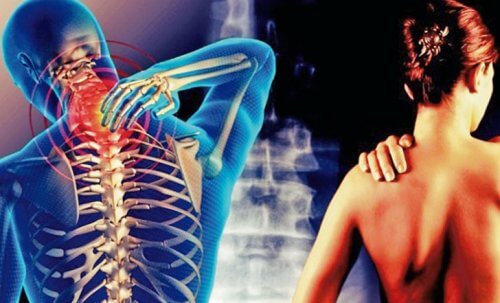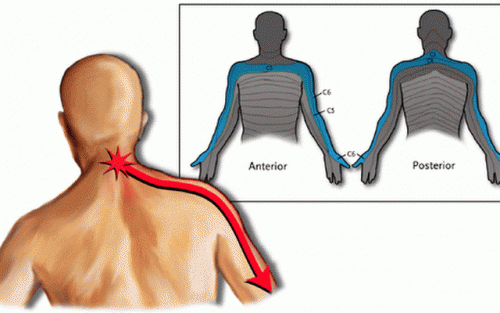Cervicobrachial Syndrome, a Painful Neck and Arms


Written and verified by the doctor Gilberto Adaulfo Sánchez Abreu
We might find the name a little disturbing, but Cervicobrachial syndrome is more common than we think. It means pain in the cervical region that begins in the neck and goes down the spinal cord until it reaches the arms and even the fingers.
It’s rather disabling. However, a common misconception in regard to this ailment is some believe it only affects people who play sports. Also, factors such as stress or chronic anxiety, and even osteoarthritis often lead to such painful disorders.
The good news is the pain usually goes away with painkillers. Unfortunately, most serious cases require surgery.
Below we’ll provide more information about this problem that most people haven’t heard of.
Cervicobrachial syndrome, when moving is painful
Moving your head, reaching for something, sitting, reading, laying down, even breathing: everything you do becomes painful. Cervicobrachial syndrome mainly affects your spine. We’re not facing a simple case of whiplash or a pulled muscle. It’s much more than that.
Imagine the region above the spinal column. This means vertebrae C1 to C7, which are precisely the smallest ones. Now, inside these tiny vertebrae are ligaments, tendons, muscles, nerve fibers… When some of these become inflamed, the pain reaches various areas of our body.
It’s common for the inflammation to begin in the spine and reach the shoulders, the shoulder blades, the arms, and even the torso.

What causes Cervicobrachial syndrome?
- Traumatic injures. As mentioned above, the main causes of Cervicobrachial syndrome are injuries stemming from an accident or playing a sport. Dislocations, fractures, sprains, and muscle tears are usually the main causes
- Similarly, prolonged periods of stress and anxiety also lead to this problem. You must take this into consideration
- Inflammatory processes such as rheumatism may also cause this
- On the other hand, people affected by degenerative diseases such as arthritis may develop Cervicobrachial syndrome over time
- We also cannot leave out infectious diseases such as tuberculosis
Read also How to Treat Sprain Symptoms Naturally
What are the symptoms?
Surely you’ve heard someone say, “It’s like I’ve been stabbed in the back.” It’s something similar, in a way. The difference is that, in addition to this focal point, the pain also spreads to other regions of the body in the form of very intense heat.
- In addition to the pain described above, Cervicobrachial syndrome is also characterized by intense cramps, sensitivity disorders, muscle weakness, tingling, or a sensation of intense cold or heat, kind of like a burn
- At the same, it’s possible that we experience headaches, neck stiffness, dizziness, or nausea when sitting… Almost any movement is accompanied by intense discomfort.
What are the treatments?

Cervicobrachial syndrome requires a highly personalized treatment that only health professionals can offer. In the first place, it’s necessary to use the correct drugs to reduce the inflammation.
Physiotherapy plays a part in battling the pain and restoring movement to the extremities.
Another appropriate technique is hot and cold therapy. Hot showers, hot water bags, and even massages with rosemary and alcohol are very effective.
We also cannot forget that when we’re diagnosed with Cervicobrachial Syndrome, it’s necessary to rest a lot. Specialists recommend resting on your back with the arm that is experiencing pain just behind your head.
Read also 6 Body Parts You Should Massage
Cervicobrachial Syndrome has a good prognosis

The cervicobrachial syndrome has generally a good prognosis. What does this mean? It means that people with a good clinical history have a natural tendency towards improvement within four to six weeks.
Without a doubt, the essential problem is with patients with some form of rheumatism or arthritis. When confronted with chronic diseases, it’s normal to experience some periods of improvement mixed in with weeks of intense discomfort.
You must do anything you can to lead a healthy lifestyle if you suffer from this kind of discomfort. A balanced diet, moderate exercise, and monitoring your focal points of stress and anxiety is helpful.
For patients with more complex symptoms, it’s possible to consider surgery. However, our doctors will always make that decision.
All cited sources were thoroughly reviewed by our team to ensure their quality, reliability, currency, and validity. The bibliography of this article was considered reliable and of academic or scientific accuracy.
- Moretti, B., Vetro, A., Garofalo, R., Moretti, L., Patella, S., Patella, V., & Simone, C. (2004). Manipulative therapy in the treatment of benign cervicobrachialgia of mechanical origin. La Chirurgia Degli Organi Di Movimento.
- Persson, L. C. G., & Carlsson, J. Y. (1999). Headache in patients with neck-shoulder-arm pain of cervical radicular origin. Headache. https://doi.org/10.1046/j.1526-4610.1999.3903218.x
- https://www.physio-pedia.com/Cervicobrachial_Syndrome
This text is provided for informational purposes only and does not replace consultation with a professional. If in doubt, consult your specialist.








